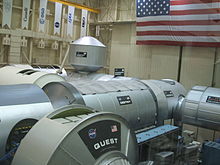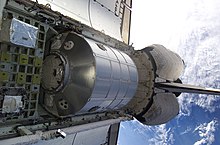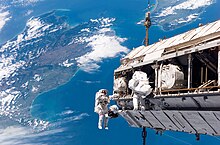Assembly of the International Space Station
This article needs additional citations for verification. (November 2008) |
This article needs to be updated. |


The Assembly of the International Space Station is a major aerospace engineering endeavour being conducted in Low Earth orbit by a consortium of governmental and inter-governmental space agencies.
Zarya, the first ISS module, was launched by a Proton rocket on 20 November 1998. The STS-88 shuttle mission followed two weeks after Zarya was launched, bringing Unity, the first of three node modules, and connecting it to Zarya. This bare 2-module core of the ISS remained unmanned for the next one and a half years, until in July 2000 the Russian module Zvezda was added, allowing a minimum crew of two astronauts or cosmonauts to be on the ISS permanently.
When assembly is complete, the ISS will have a pressurized volume of approximately 1,000 cubic meters, a mass of approximately 400,000 kilograms, approximately 100 kilowatts of power output, a truss 108.4 meters long, modules 74 meters long, and a crew of six. Building the complete station will require more than 40 assembly flights. Of these flights, 35 are planned to be Space Shuttle flights, with 26 ISS-shuttle flights flown and 9 more planned between 2008 and 2010. Other assembly flights consist of modules lifted by the Russian Proton rocket or in the case of the Pirs Airlock by a Soyuz-U rocket.
Logistics

The space station is located in orbit around the Earth at an altitude of approximately 360 km (220 miles), a type of orbit usually termed low Earth orbit (the actual height varies over time by several kilometers due to atmospheric drag and reboosts). It orbits Earth in a period of about 90 minutes; by August 2007 it had completed more than 50,000 orbits since launch of Zarya on 20 November 1998.
A total of 14 main pressurized modules are scheduled to be part of the ISS by its completion date in 2010.[1] A number of smaller pressurized sections will be adjunct to them (Soyuz spacecraft (permanently 2 as lifeboats - 6 months rotations), Progress transporters (2 or more), the Quest and Pirs airlocks, as well as periodically the Multi-Purpose Logistics Module, the Automated Transfer Vehicle and the H-II Transfer Vehicle).
The ISS, when completed, will consist of a set of communicating pressurized modules connected to a truss, on which four large pairs of photovoltaic modules (solar panels) are attached. The pressurized modules and the truss will be perpendicular: the truss spanning from starboard to port and the habitable zone extending on the aft-forward axis. Although during the construction the station attitude may vary, when all four photovoltaic modules are in their definitive position the aft-forward axis will be parallel to the velocity vector.[2]
In addition to the assembly and utilization flights, approximately 30 Progress spacecraft flights are required to provide logistics until 2010. Experimental equipment, fuel and consumables are and will be delivered by all vehicles visiting the ISS: the Shuttle, the Russian Progress, the European ATV and the Japanese HTV.
Columbia disaster and changes in construction plans

Disaster and consequences

At one point, there was some uncertainty over the future of the ISS. The Space Shuttle Columbia disaster on 1 February 2003, the subsequent two and a half year suspension of the U.S. Space Shuttle program, followed by problems with resuming flight operations in 2005, were major obstacles.
The Space Shuttle program resumed flight on 26 July 2005, with the STS-114 mission of Discovery. This mission to the ISS was intended both to test new safety measures implemented since the Columbia disaster, and to deliver supplies to the station. Although the mission succeeded safely, it was not without risk; foam was shed by the external tank, leading NASA to announce future missions would be grounded until this issue was resolved.
Between the Columbia disaster and the resumption of Shuttle launches, crew exchanges were carried out solely using the Russian Soyuz spacecraft. Starting with Expedition 7, two-astronaut caretaker crews were launched in contrast to the previously launched crews of three. Because the ISS had not been visited by a shuttle for an extended period, a larger than planned amount of waste accumulated, temporarily hindering station operations in 2004. However Progress transports and the STS-114 shuttle flight took care of this problem.
Changes in construction plans

ISS construction is now far behind the original planned schedule for completion in 2004 or 2005. This is mainly due to the halting of all NASA Shuttle flights following the Columbia disaster in early 2003 (although there had been prior delays due partly to Shuttle problems, and partly to delays stemming from the Russian space agency's budget constraints). During the shuttle stand-down, construction of the ISS was halted and the science conducted aboard was limited due to the crew size of two.
As of the beginning of 2006, many changes were made to the originally planned ISS, even before the Columbia disaster. Modules and other structures were cancelled or replaced and the number of Shuttle flights to the ISS was reduced from previously planned numbers. Still, the newest ISS Shuttle launch manifest and the ISS design scheme reveal that more than 80% of the hardware intended to be part of the ISS in the late 90s is still planned to be orbited to the ISS by its scheduled completion date in 2010.
In March 2006, a meeting of the heads of the five participating space agencies accepted the new ISS construction schedule that plans to complete the ISS by 2010.[3] A crew of six has been established as of May 2009, after the Shuttle's next 12 construction flights following the second Return to Flight mission STS-121. Requirements for stepping up the crew size included enhanced environmental support on the ISS, a second Soyuz permanently docked on the station to function as a second 'lifeboat', more frequent Progress flights to provide double the amount of consumables, more fuel for orbit raising maneuvers, and a sufficient supply line of experimental equipment.
Assembly sequence

The ISS consists of ten main pressurized modules: four US modules (Destiny, Unity, Quest and Harmony), three Russian modules (Zarya, Zvezda, and Pirs ), two Japanese modules (the JEM-ELM-PS and JEM-PM) and one European module (Columbus). Spacecraft docked to the ISS also extend the pressurized volume. At least one Soyuz spacecraft is always docked as a 'lifeboat' and is replaced every six months by a new Soyuz as part of crew rotation.
Although not permanently docked with the ISS, a Multi-Purpose Logistics Module (MPLM) forms part of the ISS during Shuttle missions that include an MPLM. The MPLM is attached to Unity and later to Harmony and is used for resupply and logistics flights.
The table below shows the sequence in which these components were or will be added to the ISS. The numbers provided are indications and represent launch weight and dimensions.
| Element | Assembly flight |
Launch date |
Launch vehicle |
Length (m) |
Diameter (m) |
Mass (kg) |
Isolated View | Station View |
|---|---|---|---|---|---|---|---|---|
| Zarya (FGB)[4] | 1A/R | 1998-11-20 | Proton-K | 12.6 | 4.1 | 19,323 | 
|

|
| Unity (Node 1)[5] | 2A | 1998-12-04 | Space Shuttle Endeavour (STS-88) | 5.49 | 4.57 | 11,612 | 
|

|
| Zvezda (Service Module)[6] | 1R | 2000-07-12 | Proton-K | 13.1 | 4.15 | 19,051 | 
|

|
| Z1 Truss & PMA-3 | 3A | 2000-10-11 | Space Shuttle Discovery (STS-92) | 4.9 (Z1) | 4.2 (Z1) | 8,755 (Z1) | 
|

|
| P6 Truss & Solar Arrays | 4A | 2000-11-30 | Space Shuttle Endeavour (STS-97) | 73.2 | 4,9 | 15,824 | 
| |
| Destiny (US Laboratory)[7] | 5A | 2001-02-07 | Space Shuttle Atlantis (STS-98) | 8.53 | 4.27 | 14,515 | 
|

|
| External Stowage Platform-1 | 5A.1 | 2001-03-08 | Space Shuttle Discovery (STS-102) | 
|

| |||
| Canadarm2 (SSRMS) | 6A | 2001-04-19 | Space Shuttle Endeavour (STS-100) | 17.6 | 0.35 | 4,899 | 
|

|
| Quest (Joint Airlock)[8] | 7A | 2001-07-12 | Space Shuttle Atlantis (STS-104) | 5.5 | 4 | 6,064 | 
|

|
| Pirs (Docking Compartment & Airlock) | 4R | 2001-09-14 | Soyuz-U (Progress M-SO1) |
4.91 | 2.55 | 3,580 | 
|

|
| S0 Truss[9] | 8A | 2002-04-08 | Space Shuttle Atlantis (STS-110) | 13.4 | 4.6 | 13,970 | 
|

|
| Mobile Base System | UF2 | 2002-06-05 | Space Shuttle Endeavour (STS-111) | 5.7 | 2.9 | 1,450 | 
|

|
| S1 Truss | 9A | 2002-10-07 | Space Shuttle Atlantis (STS-112) | 13.7 | 4.6 | 14,120 | 
|

|
| P1 Truss | 11A | 2002-11-23 | Space Shuttle Endeavour (STS-113) | 13.7 | 4.6 | 14,000 | 
|

|
| ESP-2 | LF1 | 2005-07-26 | Space Shuttle Discovery (STS-114) | 3.65 | 4.9 | 2,676 | 
|

|
| P3/P4 Truss & Solar Arrays[10] | 12A | 2006-09-09 | Space Shuttle Atlantis (STS-115) | 13.8 | 4.9 | 15,900 | 
|

|
| P5 Truss[11] | 12A.1 | 2006-12-09 | Space Shuttle Discovery (STS-116) | 3.4 | 4.6 | 1,818 | 
|

|
| S3/S4 Truss & Solar Arrays | 13A | 2007-06-08 | Space Shuttle Atlantis (STS-117) | 13.8 | 4.9 | 15,900 | 
|

|
| S5 Truss and ESP-3 | 13A.1 | 2007-08-08 | Space Shuttle Endeavour (STS-118) | 13.7 | 3.9 | 12,598 | 
|

|
| Harmony (Node 2) Relocation of P6 Truss |
10A | 2007-10-23 | Space Shuttle Discovery (STS-120) | 7.2 | 4.48 | 14,288 | 
|

|
| Columbus (European Laboratory)[12] | 1E | 2008-02-07 | Space Shuttle Atlantis (STS-122) | 7 | 4.5 | 12,800 | 
|

|
| Dextre (SPDM) Japanese Logistics Module (ELM-PS) |
1J/A | 2008-03-11 | Space Shuttle Endeavour (STS-123) | 3.9 (ELM-PS) | 4.4 (ELM-PS) | 4,200 (ELM-PS) | 
|

|
| Japanese Pressurized Module (JEM-PM) JEM Robotic Arm (JEM-RMS)[13][14] |
1J | 2008-05-31 | Space Shuttle Discovery (STS-124) | 11.2 (JEM-PM) | 4.4 (JEM-PM) | 15,900 (JEM-PM) | 
|

|
| S6 Truss & Solar Arrays | 15A | 2009-03-15 | Space Shuttle Discovery (STS-119) | 73.2 | 10.7 | 15,900 | 
|

|
| Japanese Exposed Facility (JEM-EF) | 2J/A | 2009-07-15 | Space Shuttle Endeavour (STS-127) | 4,100 | 
|

| ||
| Poisk (MRM-2)[15][16] | 5R | 2009-11-10 | Soyuz-U (Progress M-MRM2) |

|

| |||
| EXPRESS Logistics Carriers 1 & 2 | ULF3 | 2009-11-16 | Space Shuttle Atlantis (STS-129) | 
|

| |||
| Tranquillity (Node 3) Cupola |
20A | 2010-02-08 | Space Shuttle Endeavour (STS-130) | 6.5 | 4.25 | 12,247 | 
| |
| Cupola | 20A | 2010-02-08 | Space Shuttle Endeavour (STS-130) | 1.5 (Cupola) | 2.95 (Cupola) | 1,800 (Cupola) | 
|
|
| Rassvet (MRM-1) ICC-VLD[17] |
ULF4 | 2010-05-14 (scheduled) | Space Shuttle Atlantis (STS-132) | |||||
| Alpha Magnetic Spectrometer and EXPRESS Logistics Carrier 3 | ULF6 | 2010-07-29 (scheduled) | Space Shuttle Endeavour (STS-134) | 6,731 (AMS-02) | 
|
|||
| Leonardo (PMM) and EXPRESS Logistics Carrier 4 | ULF5 | 2010-09-16 (scheduled) | Space Shuttle Discovery (STS-133) | |||||
| Nauka (MLM) European Robotic Arm[18] |
3R | 2011-12-?? (scheduled) | Proton-M | 
|
Cancelled modules
- Interim Control Module - no need to replace Zvezda (in storage ready to launch at short notice if required)
- ISS Propulsion Module - no need to replace Zvezda
- Habitation Module (HAB) - With the cancellation of the Habitations Module, sleeping places are now spread throughout the station. There will be three in the Russian segment once the ISS is completed and three in the US segment. It is however not necessary to have a separate 'bunk' in space at all, many visitors just strap their sleeping bag to the wall of a module, get into it and sleep.
- Crew Return Vehicle (CRV) - utilizing two Soyuz crafts instead
- Centrifuge Accommodations Module (CAM) - would have been attached to Node 2, now named Harmony
- Science Power Platform (SPP) - power will be provided to the Russian segments partly by the US solar cell platforms
- Russian Research Modules (RM1 and RM2) - to be replaced by single Multipurpose Laboratory Module (Nauka)
- Universal Docking Module (UDM) - canceled along with the Research modules that were supposed to connect there
Proposed modules
The following modules are proposed, but not yet confirmed in the ISS launch manifests.
- British Habitation Extension Modules
- Russian Nodal Module - UDM with proposed launch in 2013 [19][20]
- Russian Science-Power Module-1 - combination of RM1 and parts of SPP with proposed launch in 2014 [19][20]
- Russian Science-Power Module-2 - combination of RM2 and parts of SPP with proposed launch in 2015 [19][20]
Formerly proposed and later abandoned modules:
- Russian Commercial Enterprise Module entertainment and studio module.[21]
See also
For the full list of ISS flights see the List of unmanned spaceflights to the ISS and List of human spaceflights to the ISS
External links
- Animated ISS assembly process, mission designations and dates are included.
- Diagram of planned components of the ISS, positions of cancelled modules can be seen.
References
- ^ "NASA - Consolidated Launch Manifest". NASA. Retrieved 2006-07-15.
- ^ "What are the ISS attitudes?" (Flash). NASA. Retrieved 2006-09-11.
- ^ flightglobal.com "NASA commits to Shuttle missions to International Space Station". International Space Station. FlightGlobal. 3 March 2006. Retrieved 16 September 2006.
{{cite web}}: Check|url=value (help); Cite has empty unknown parameter:|coauthors=(help); Unknown parameter|dateformat=ignored (help) - ^ Mark Wade (15 July 2008). "ISS Zarya". Encyclopaedia Astronautica. Retrieved 2009-03-11.
- ^ "Unity Connecting Module: Cornerstone for a Home in Orbit" (PDF). NASA. January 1999. Retrieved 2009-03-11.
- ^ "Zvezda Service Module". NASA. 11 March 2009. Retrieved 2009-03-11.
- ^ "NASA - US Destiny Laboratory". NASA. 26 March 2007. Retrieved 2007-06-26.
- ^ "Space Station Extravehicular Activity". NASA. 4 April 2004. Retrieved 2009-03-11.
- ^ "Space Station Assembly: Integrated Truss Structure". Retrieved 2007-12-02.
- ^ "P3 and P4 to expand station capabilities, providing a third and fourth solar array" (pdf). Boeing. 2006. Retrieved 2007-12-02.
{{cite web}}: Unknown parameter|month=ignored (help) - ^ "STS-118 MISSION OVERVIEW: BUILD THE STATION…BUILD THE FUTURE" (PDF). NASA PAO. 2007. Retrieved 2007-12-02.
{{cite web}}: Unknown parameter|month=ignored (help) - ^ "Columbus laboratory". ESA. 10 January 2009. Retrieved 2009-03-06.
- ^ "About Kibo". JAXA. 25 September 2008. Retrieved 2009-03-06.
- ^ "NASA - Kibo Japanese Experiment Module". NASA. 23 November 2007. Retrieved 2008-11-22.
- ^ Anatoly Zak. "Docking Compartment-1 and 2". RussianSpaceWeb.com. Retrieved 26 March 2009.
- ^ Chris Bergin (10 November 2009). "Russian module launches via Soyuz for Thursday ISS docking". NASASpaceflight.com. Retrieved 10 November 2009.
- ^ "NASA Extends Contract With Russia's Federal Space Agency". NASA. 9 April 2007. Retrieved 2007-06-15.
- ^ "FGB-based Multipurpose Lab Module (MLM)". Khrunichev State Research and Production Space Centre. Archived from the original on 2007-09-27. Retrieved 2008-10-31.
- ^ a b c "Russia Needs Billions More To Complete It's ISS Segment". Space-Travel.com. 14 April 2008. Retrieved 2009-01-29.
- ^ a b c Sergei Shamsutdinov (July 2008). "Program for Development of the Russian ISS Segment" (in Russian). Novosti Kosmonavtiki. Retrieved 2009-02-15.
- ^ Anatoly Zak. "Russian segment of the ISS". russianspaceweb.com. Retrieved 3 October 2009.

